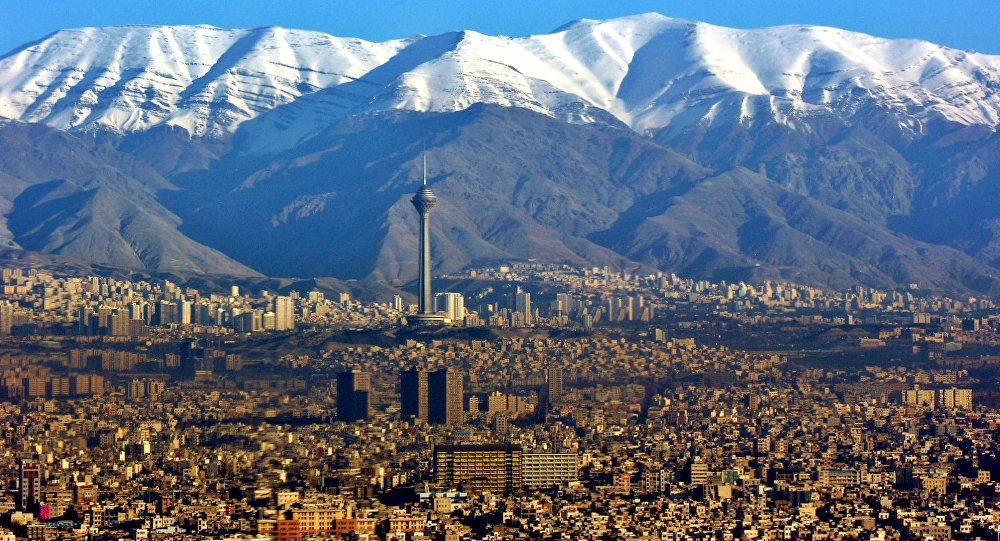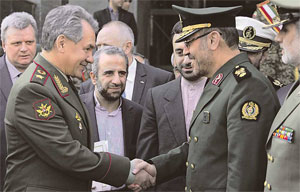Iran is the most promising goal for military and technical cooperation

© Flickr/ peyman abkhezr
Originally appeared at VPK, translated by Carpatho-Russian exclusively for SouthFront
Removal of economic sanctions allowed Tehran to de-freeze about 40 billion dollars in foreign banks. Of this, eight billion are planned to be directed towards purchase of modern weapons and military equipment. What are Russia’s chances?
The influence of the Islamic Republic of Iran is growing. The active involvement of the country in the tumultuous processes of the reorganization of the Middle East determines the prospects for stabilization of this major region and its future geopolitical configuration. Iran is actively joining in the armed fight, albeit for a time and informally, through advisers and volunteers. Taking into account the formation of a new system of the relations in the region, it is interesting to estimate the military capabilities of the country. Iran possesses the second economic potential after Turkey in the Middle East and in the Islamic world. And in the technological relation it is one of the most highly developed states of the region. Here, it occupies an exclusively favorable situation in the geopolitical relation in Eurasia and has huge stocks of hydrocarbons.
Iran is the most promising weapons market for our country. For this reason any hasty or unreasoned decisions can only do harm. It is not surprising that the military-political leadership of Russia is strengthening the mutual relations with an important ally consistently and without any pressure. Recent official contacts also testify to this.
“China even in the conditions of sanctions continued to cooperate with Iran, including in the military-technical area”
In February Moscow was visited by the Minister of Defense and Support of the Armed Forces of Iran, Brigade General Hossein Dehgan. During his official visit, he met President Vladimir Putin, his Assistant on Military Technical Cooperation Vladimir Kozhin, his colleague General Sergey Shoigu, and the curator of the Russian “defense industry” Deputy Prime Minister Dmitry Rogozin. Sergey Shoigu visited Tehran with a reciprocal visit on February 21. The head of the military department of Russia was received by President Hasan Rouhani, his Iranian colleague, and other members of the government.
It is clear that this was not simply an exchange of courtesies, but a fundamentally business-oriented conversation with a discussion of significant questions for both countries. It is enough to note that the Ministers of Defense were received by the Presidents. Implementation of the Intergovernmental Agreement signed in January, 2015 about military cooperation was one of the main goals of the negotiations.
Common threats
Since the 1592 establishment of bilateral relations, Iran has been an important political and trading partner for Russia. For example, in 1913 3.8 percent of the Russian export and 3.3 percent of import were its share.

Collage by Andrey Sedykh
Present Iran is the largest state of the Near and Middle East, with two and a fraction times as much territory as Turkey. Of 5580 kilometers of border, one third is the coastline which is washed by waters of the Caspian Sea, Hormuz and Persian Gulfs. The geopolitical situation has predetermined the relationship of our countries, relations of which have not at all been an equal two-way road.
Today, after a certain inactivity, rapid growth of positive tendencies in Russian-Iranian relations is noted. The main reason for this is the commonality of external threats and interests. With growing regional instability, Russia and Iran are considered by some large players as the main targets. A year ago, our political community and officials openly declared the impossibility of ensuring national security in the southern direction without close cooperation with Tehran. This axiom was confirmed by the subsequent joint actions, which have stopped the criminal activity of IS, forbidden in Russia. It was specifically the successes of our countries, rather than of the western coalition, that set a barrier in a path of the militants and were the basis for a possible truce in Syria.
A common position also pulls us together in relation to the USA, at whose initiative the international sanctions had been imposed against Iran in effect for 32 years, and also against Russia. Instead of the result desired by the West, these measures were a uniting factor in the attempt of Tehran and Moscow to overcome the negative consequences of restrictions. It is important to mention also the similarity of the Russian concept of a multipolar world with the Iranian doctrine of dialogue of civilizations.
Military and technical cooperation always occupied a special place in Iran-Russian relations New challenges demand not simply its strengthening, but also integration of Tehran into Collective Security Treaty Organization programs.
What is lacking
The army of Iran is well equipped and prepared, to such an extent that any thoughts of forced invasion onto its territory are now practically doomed to failure. And all the same the current state of arms and military equipment leaves much to be desired, with one small exception. Modernization will allow resistance to aggression with minimal losses. This concerns first of all combat aircraft, 80% of which are technically faulty and need major maintenance, with about 20% of aircraft not combat ready.
The situation is not better in the ship component of the Iranian Naval Forces, where practically all samples of out-of-date projects were constructed in the USA and Great Britain. Today their combat readiness does not exceed 60 percent due to the lack of spare parts. Of the three submarines of the Varshavyanka type of Russian production, on the average two need major maintenance.
The main reason for such condition of the weapons and military equipment is the long international sanctions. Now the equipment who was put in before the end of the 1970s is subject to replacement and modernization. Subsequently the IRI’s opportunites to upgrade the available potential were extremely limited. The wager on its own forces was not fully justified.

novostimira.net
In foreseeable prospects, the main efforts of the military-political leadership of the IRI to equip the national armed forces with necessary weapons and military equipment will, it is thought, be concentrated on modernizing existing test pieces and developing their own on the basis of copying foreign ones. Beginning large-scale production of modern weaponry is improbable in view of the insufficiency or absence of a necessary industrial base.
Nevertheless, in difficult financial and economic conditions Iran created a number of systems in several critically important areas. The country makes mechanized infantry vehicles, tanks, self-propelled artillery systems, multiple rocket launch system, and anti-tank guided missiles, and military rocketry, including long-range, is being developed. In Iran there is some capacity for creation and mass production of modern samples. However, this is possible only when military-technical assistance is rendered from a country developed industrially.
Russia is such a partner for Iran. Connected by obligations with Israel and other potential opponents of the Islamic Republic, the USA and its allies do not yet show readiness for such cooperation at the official level. The fact that countries which have taken such a path have subsequently paid for it with blood and instability does not promote this choice to their advantage.
In addition, most of Iran’s arms and equipment are of Soviet production, and the country will not undertake its complete replacement with a transition to western standards, which will certainly be an indispensable condition. If it consents to this, the Islamic Republic of Iran will fall into eternal weapons servitude from which it will not get out. All of this significantly increases the chances of Russia to take the dominant positions in the Iranian weapons market. The high probability of this option to our advantage is confirmed by the repeatedly stated wishes of the Iranian leadership, the same Hossein Dehgan about revival of effective mutually- beneficial military and technical cooperation.
Plus the honor code
The specifics are in the document which has already been transferred to Moscow and is being studied by experts. Analysts consider that the discussion is about a package of contracts no less than eight billion dollars.
Among the prime demands, as experts believe, are fighters of the Su-30SM type and Yak-130 combat-capable training aircraft and the Mi-8 and Mi-17 family of helicopters. Regarding the maritime area, Iran may be interested in the coastal mobile Bastion missile system with the Yakhont anti-ship missile, surface ships, and diesel engine – electric submarines .
One may be sure of the desire of Tehran to considerably update its stock of various anti-aircraft weapons, and also to execute at last the broken S-300 contract that had been earlier concluded with Russia. Along with this, the probability is very high to receive an offer from Iran to modernize the Soviet long-range S-200 anti-aircraft missile system, the S-75 and Kvadrat complexes, and also facilities for radar intelligence collection and management.
The range of requests from Iran is very large. However, one must deal with economic realities. Tehran can express its wishes, a number of which should be executed on credit. This will undoubtedly demand painstaking and careful negotiations which are already being conducted.
What is Russia prepared to offer? In principle, everything from the specified designations. Among samples previously unnamed, there could be AWACS aircraft of the A-10 type and military transport helicopters of different function, and missile boats equipped with Kalibers. It is impossible to exclude also the T-90 tanks with modern active-defense capabilities, and land and air- based anti-tank missiles.
Certainly, Russia today is not in a condition, as it once was in the USSR, to deliver arms to friendly countries, giving them credits of many millions which were not paid subsequently. Compromise solutions must be found. One of such paths is localization of the production of separate samples of weapons and military equipment, and also creation of a network of service centers for repair and modernization of available equipment in the territory of Iran.
Another indispensable condition for Russia must be strict implementation of the accepted obligations without politicization and artificial delaying. The negative experience with the S-300 contract must not be repeated. In addition, one should constantly remember those who are breathing down our back and wishing to conclude similar transactions. And Iran can use such a possibility with weakening sanctions, addressing similar offers to China and other competitors of Russia in the weapons business. There is no doubt that they will not miss this chance. Even in the conditions of sanctions, China continued to cooperate with Iran, including in the military area.
A tender can be announced for delivery of separate samples. But Russia must also participate in this case. We have developments which can be finished off for joint financial security, and not be inferior in their capabilities to the western analogs. A striking example is creation of the multi-purpose Russian-Indian BraMos cruise missile with high export potential.
Today Iran is the last large weapons market. The possibilities of further growth of our export at the expense of traditional partners — India, Algeria, China, and Vietnam – are approaching a limit. Prospects for military-technical cooperation with neighboring Iraq are far from unambiguous.
And the main thing is that if we will not back up Iran, as earlier due to various reasons we did not support Iraq, Libya and Yugoslavia in due time, we can end up in a situation where a real opponent will be threatening our borders.
Anatoly Sokolov, Kandidat of Military Sciences



